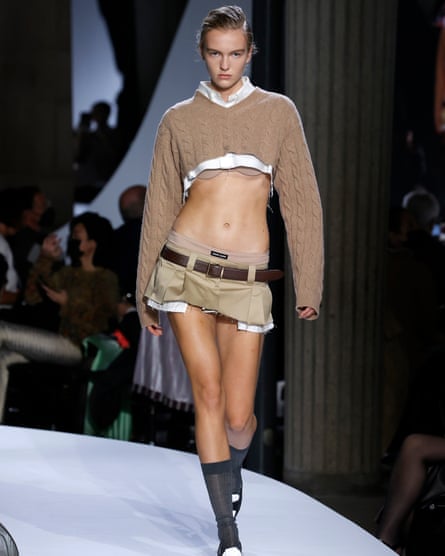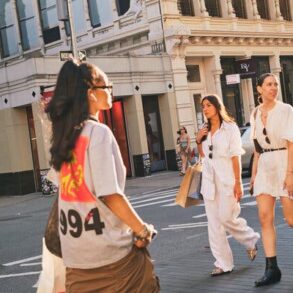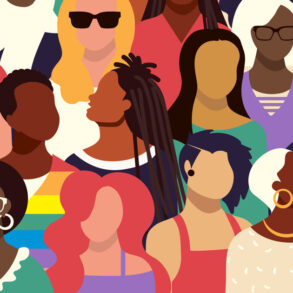This summer might have been a washout, but that’s not immediately obvious when walking down a typical UK high street. Along with sandals, sunglasses and shorts, any fashion-conscious observer might notice something else: the ubiquitous midriff.
Making a showcase of this part of the body is not so much a trend as a given for young consumers – so much so, in fact, that this year marks 10 years since the midriff became an established fashion statement.
In 2013, cropped garments began to appear on the catwalk by brands including Balenciaga, Louis Vuitton and Roksanda Ilinĉić. Celebrities including Miley Cyrus and January Jones started to display their stomachs more. The bare midriff as fashion statement was given a major credibility boost when Beyoncé appeared on the cover of BritishVogue for the first time, wearing a high-waisted skirt and cropped T-shirt by designer Jonathan Saunders.
Yet despite its longevity, the look appears to have reached its peak this summer, thanks to various midriff-baring items all being fashionable at the same time.
From crop tops to low-rise jeans, hip-slung skirts to shrunken baby tees, stomachs are on display like never before.
Fashion resale app Depop reports that searches for baby tees, crop tops and low-rise jeans have soared during August. Tagwalk, the search engine that collates trends at fashion shows, say that since 2019 about 15% of all clothing on the catwalk for spring/summer shows has shown midriffs.

This month, Fashion Museum Bath announced that its Dress of the Year for 2022, chosen by Elle UK’s editor-in-chief Kenya Hunt, wasn’t a dress at all – it was a micro-miniskirt and cropped sweater.
Designed by Miuccia Prada for Miu Miu, it swiftly went viral thanks to celebrities including Emma Corrin and Hunter Schafer, and DIY tutorials on TikTok.
The post-pandemic world is part of why we are seeing more midriff, say some trend watchers. “Post Covid, the womenswear wardrobe was very oversized and had a tendency to hide the body,” says Alexandra Van Houtte, founder of Tagwalk. “Since then, there has been a boost in women’s attitude, with powerful bodycon dresses, crop tops and bold colours.”
Gen Z is also crucial. While Nicole Kidman has worn the Miu Miu skirt and Gwyneth Paltrow trialled the so-called “midlife midriff” on the red carpet, most of the people showing this part of the body are young. “The ‘baggy pants-tiny top’ method is something Gen Z does often,” says Aiyana Ishmael, associate editor of Teen Vogue. “It’s the perfect formula when getting dressed for the day.”
Before this decade, the last time that we saw a lot of midriff was the early 00s when stars like Britney Spears, Paris Hilton and Destiny’s Child regularly showed acres of toned stomach. This era – often known as Y2K – is in focus for twentysomethings.
The baby tee is a wholesale revival from this era. Vanna Youngstein launched her baby tee brand in 2016, inspired by the Y2K era. Her designs have been worn by celebrities including Emily Ratajkowski and in hit TV show Euphoria, and they frequently sell out. Youngstein says the style is successful because it covers several bases: “you can wear them with anything and the silhouette will look fresh and modern as well as nostalgic-looking.”
The corset is another popular item that sees its wearer expose their midriff. Alexia Elkaim’s brand, Miaou, is a favourite.
She says this part of the body is key: “I typically like to design corsets that are shorter on the sides to accentuate midriff.”
Elkaim herself wears this style – baggy trousers and a short corset is her go-to outfit. Fashion curator Shonagh Marshall says the midriff can be seen in western fashion throughout the 20th century. She references Chicago’s World Fair in 1893 as important, with belly dancing from the Middle East performed. “I think people thought it was something a bit daring. It was probably an area that no one apart from you had ever really seen.”
after newsletter promotion




Midriff-baring clothing goes beyond western tradition, of course, and often has different connotations elsewhere. The cropped blouse has been worn with saris in India since the 19th century. “Showing your midriff, unlike other parts of the female body, was not considered to be erotic [in Indian culture], necessarily,” says Priya Khanchandani, curator of The Off Beat Sari at The Design Museum. “It was considered to be quite neutral.”
“Midriff” is a word that dates back to old English and was popularised in the west in the early 1940s as fashion trends revealed this part of the body. Stars like Joan Crawford, Carole Lombard and Marilyn Monroe showed their midriff with high-waisted trousers in the 40s, while the 60s and 70s saw stars including Pam Grier and Jane Birkin wear tops finishing just below the breasts, with low-slung bell bottoms. In the 80s, cropped items were part of body beautiful culture. Men including Prince and Keanu Reeves wore crop tops.
Inspired by celebrities including Lil Nas X and Troye Sivan – and early adopter Kid Cudi in 2014 – men are baring midriffs again. While it went across demographics in the 80s, this revival has been claimed by the LGBTQI+ community. After a New York Times feature on male crop tops was published, Queerty reported that “Gay Twitter” has chimed in, “declaring homosexual ownership of the crop-top”.
Pressure for women to have the perfect physique has often been an issue with cropped designs. This was the case in the Y2K era when size zero was the body ideal. “In the west, you think of Paris Hilton with really low-slung jeans or trousers and cropped top – this washboard stomach,” says Marshall. This was clearly still in the minds when midriffs first came back to fashion a decade ago. “The crop top is back, but don’t panic” was the headline in the Guardian.
In 2023, by contrast, the theory is stomachs can come in all shapes and sizes. Ed Conway, founder of fitness studio Fit As in Leyton, east London, reports that while men feel pressure to have a six pack, many women actively avoid this look.
“We’re moving into a better space from a body positivity point of view,” he says. “Crop-top fashion is perhaps reflecting this as many people who wear them might not have what certain aspects of society may deem ‘a perfect flat stomach’. It’s more of an empowerment to own it and not let your body shape dictate what you wear.”
It’s not always this straightforward. Khanchandani says she has seen body ideals change in Bollywood films and says the influence from the west is evident with more flat stomachs featured. Ishmael is plus size and says she has only recently “started letting” herself wear crop tops. She argues that while brands need to provide more options, consumers also need to think beyond ingrained ideas. “If your immediate thought is that it’s reinforcing thinness, that’s because you too also view this style as something meant solely for one kind of person,” she says.
Elkaim is keen that her brand is open to all. “I used to hate my midriff,” she says. “I felt I had a really soft stomach compared to what I was seeing, growing up. Now I love my midriff and design without fear of showing it.”







